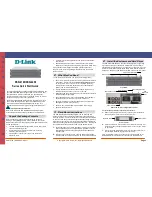
supports automatic allocation of reusable network addresses and of additional configuration
parameters.
To request the assignment of one or more IPv6 addresses, a client first locates a DHCP server
and then requests the assignment of addresses and other configuration information from the
server. The client sends a Solicit message to the All_DHCP_Relay_Agents_and_Servers
(FF02::1:2) multicast address to find available DHCP servers. Any server that can meet the
client's requirements responds with an Advertise message. The client then chooses one of the
servers and sends a Request message to the server asking for confirmed assignment of
addresses and other configuration information. The server responds with a Reply message
that contains the confirmed addresses and configuration.
IPv6 DHCP clients use link-local addresses to send and receive DHCP messages. To allow a
DHCP client to send a message to a DHCP server that is not attached to the same link, you
must configure a DHCP relay agent on the client's link to relay messages between the client
and server. The operation of the relay agent is transparent to the client.
A relay agent relays messages from clients and messages from other relay agents.
Remote ID
IPv6 DHCP Relay supports the Remote ID parameter (RFC 4649). When you enable Remote
ID on the switch, the relay agent adds information about the client to DHCPv6 messages before
relaying the messages to the DHCP server. The server can use the supplied information in the
process of assigning the addresses, delegated prefixes and configuration parameters that the
client is to receive.
The remote ID option contains two fields:
• enterprise-number
• remote-id
On the Ethernet Routing Switch 8800/8600, the enterprise-number (vendor ID) used is 1584
and the remote-id field is filled with the unique MAC address of the client.
IPv6 VRRP
For IPv6 hosts on a LAN to learn about one or more default routers, IPv6-enabled routers send
Router Advertisements using the IPv6 Neighbor Discovery (ND) protocol. The routers multicast
these Router Advertisements every few minutes.
The ND protocol includes a mechanism called Neighbor Unreachability Detection to detect the
failure of a neighbor node (router or host) or the failure of the forwarding path to a neighbor.
Nodes can monitor the health of a forwarding path by sending unicast ND Neighbor Solicitation
messages to the neighbor node. To reduce traffic, nodes only send Neighbor Solicitations to
neighbors to which they are actively sending traffic and only after the node receives no positive
indication that the neighbors are up for a period of time. Using the default ND parameters, it
takes a host approximately 38 seconds to learn that a router is unreachable before it switches to
IPv6 routing fundamentals
60 Configuration — IPv6 Routing
November 2010
Summary of Contents for ERS 8600 series
Page 14: ...New in this release 14 Configuration IPv6 Routing November 2010...
Page 78: ...IPv6 routing configuration 78 Configuration IPv6 Routing November 2010...
Page 132: ...Basic IPv6 configuration using the ACLI 132 Configuration IPv6 Routing November 2010...
Page 176: ...IPv6 routing configuration using the CLI 176 Configuration IPv6 Routing November 2010...
Page 194: ...IPv6 routing configuration using the ACLI 194 Configuration IPv6 Routing November 2010...
Page 206: ...IPv6 DHCP Relay configuration using the CLI 206 Configuration IPv6 Routing November 2010...
Page 238: ...IPv6 VRRP configuration using the CLI 238 Configuration IPv6 Routing November 2010...
Page 250: ...IPv6 VRRP configuration using the ACLI 250 Configuration IPv6 Routing November 2010...
Page 262: ...IPv6 RSMLT configuration using the CLI 262 Configuration IPv6 Routing November 2010...
Page 268: ...IPv6 RSMLT configuration using the ACLI 268 Configuration IPv6 Routing November 2010...
Page 306: ...Multicast protocol configuration using the ACLI 306 Configuration IPv6 Routing November 2010...
Page 344: ...IPv6 traffic filter configuration using the ACLI 344 Configuration IPv6 Routing November 2010...
Page 398: ...CLI show commands 398 Configuration IPv6 Routing November 2010...
















































